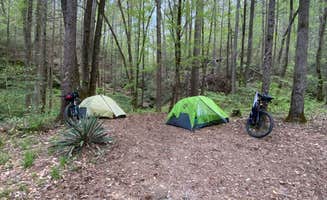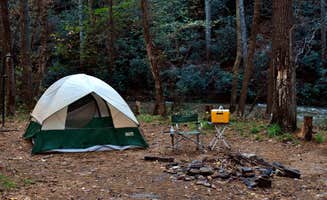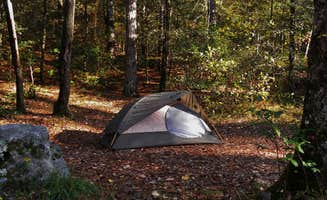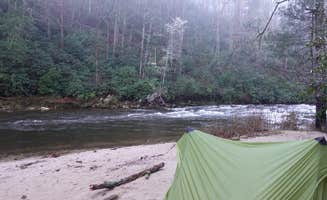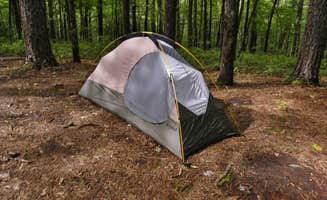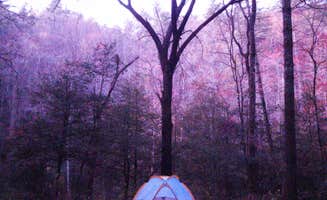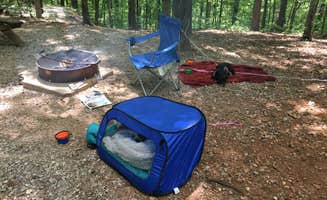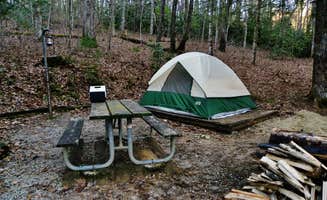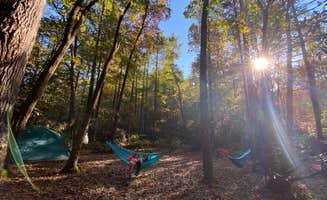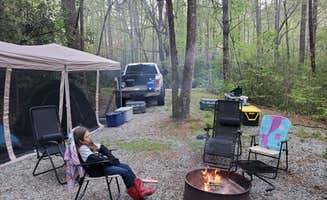Tent camping near Walhalla, South Carolina occurs at elevations between 1,200-3,000 feet, creating distinct microclimates throughout Sumter National Forest. Summer temperatures average 10-15 degrees cooler than nearby cities, while fall camping season extends longer due to the forest's protected valleys. Most campsites require either high-clearance vehicles or short hikes to access.
What to do
Trout fishing access points: Multiple campsites offer direct river access for fishing. At Burrells Ford, "Good amount of camping with a short hike in. Sites are right on the Chatooga River. This river is stocked with trout. Fishing license is required but both SC and GA are acceptable as the river is the state line."
Waterfall hiking trails: Several campsites connect to waterfall trails under 3 miles round-trip. At Riley Moore Falls Campsite, "Trail to river is well maintained and about 1 mile. It is a steep climb out. Multiple options as it is dispersed, just note restrictions on distance from river and trail."
Swimming beaches: Sandy riverside spots for cooling off during hot weather. As one camper at Sandy Beach Campsite notes, "Right next to the Chattooga river. You're on the beach." These natural beach areas provide informal swimming access during summer months when water levels drop.
Mountain biking connections: Forest roads near campsites connect to wider trail networks. Several primitive sites serve as staging areas for mountain biking routes through Sumter National Forest, with connections to longer regional trail systems.
What campers like
Secluded sites: Many campsites offer separation from other campers. At King Creek Primitive Campsites, "The second site is on the right a little more difficult to find but it's a great spot that's very secluded." These sites often require driving or hiking past more accessible areas.
River sounds: Campsites positioned near flowing water create natural white noise. Campers consistently mention the soothing effect of river sounds for sleeping, especially at sites along the Chauga and Chattooga Rivers.
Wildlife viewing: Dawn and dusk offer opportunities to spot native wildlife. Early risers frequently report deer sightings, while bird watchers document multiple species throughout the forest surrounding camp.
Fire-ready sites: Most established sites include existing fire rings. Even at remote locations, previous campers have typically created stone fire rings. However, seasonal fire restrictions may apply during dry periods.
What you should know
Road conditions: Many access roads require high-clearance vehicles. According to a review of Sumter National Forest Big Bend Campground, "It is accessible only by driving on a one and a half mile forest road that is rough with lots of rocks and pot holes. You cannot drive to this site with a low clearance sedan."
Water availability: No potable water exists at most sites. All drinking water must be packed in or filtered from rivers. Even during rainy seasons, reliable treated water sources remain unavailable at primitive sites.
Restroom facilities: Most sites have no toilet facilities. Only select areas like Grapevine feature pit toilets. As one camper noted, "Just find your place in the woods. All water has to be taken in since there are no sources of water within miles."
Cell service gaps: Expect limited or no connectivity throughout the forest. Coverage maps show significant dead zones, particularly in river valleys and remote camping areas. Emergency communications may require hiking to higher elevations.
Tips for camping with families
Gradual introduction: Start with more established campsites before trying remote options. Families new to tent camping should begin at sites like Grapevine before advancing to more primitive locations.
Wildlife precautions: Proper food storage is essential. At Grapevine, "It does it pretty busy during the weekends, summertime, and holiday/long weekends. It is right next to the Chauga River, which makes it really nice for swimming and fishing. I actually saw some people cooking up fish in their campsite that they caught that day."
Campsite selection: Look for naturally level sites when camping with children. A reviewer of Big Bend noted, "There is only one fire pit, but you can set up a half dozen tents in the area. Most of the places are not level. I managed to find one of only two level places to set up my tent."
Weather preparation: Pack for significant temperature fluctuations between day and night. Higher elevation sites can experience overnight temperatures 20+ degrees cooler than daytime highs, requiring appropriate sleeping bags and layered clothing.
Tips from RVers
Size limitations: Keep RVs under 25 feet for forest road access. Most roads leading to campsites have tight turns and limited turnaround space, making larger RVs impractical.
Camping alternatives: Consider base camping at developed campgrounds. RVers often use nearby state parks as base camps for day trips to the more primitive areas of Sumter National Forest.
Ground conditions: Prepare for potentially soft ground at river sites. During wet seasons, even high-clearance vehicles can encounter challenging conditions at water-adjacent camping areas.
Pre-arrival scouting: Research current road conditions before bringing any RV. At Blue Valley Dispersed Camping, a camper advises: "Directions: From Highlands, follow NC 28 south about 5.5 miles and turn right onto Blue Valley Rd. (S.R. 1618) at the sign. The pavement will end in a half mile. Just stay on the main path for just little over 3 or so miles."


